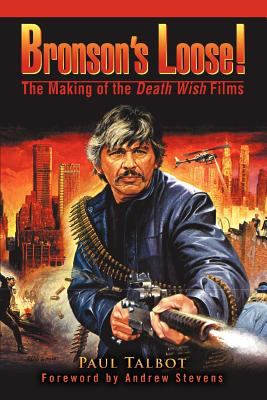 By PAUL TALBOT (iUniverse; 2006)
By PAUL TALBOT (iUniverse; 2006)
…an enjoyable history of the DEATH WISH phenomenon…
Right now, with the Eli Roth directed remake of 1974’s DEATH WISH currently in theatrical release, I’d say it’s an opportune time for a look back at this book. It’s an enjoyable history of the DEATH WISH phenomenon—novel, original film and four sequels—by author Paul Talbot, of the essential MANDINGO history MONDO MANDINGO.
As its title makes clear, the major focus of BRONSON’S LOOSE! is on DEATH WISH’S iconic star: the late Charles Bronson, apparently “one of the most exciting and unique screen personalities in film history.” Bronson’s brooding, taciturn presence was a large part of what made DEATH WISH the iconic success it was (and a primary reason the remake, starring Bruce Willis, isn’t nearly as effective). He of course played Paul Kersey, a mild-mannered NYC based architect who embarks on a vigilante spree after his wife is killed and his daughter driven mad by a band of rapists (one of them played by a young Jeff Goldblum).
As its title makes clear, the major focus of BRONSON’S LOOSE! is on DEATH WISH’S iconic star: the late Charles Bronson…
The then 53 -ear-old Charles Bronson was the biggest movie star in the world in ‘74, with international hits like ONCE UPON A TIME IN THE WEST, RED SUN, THE MECHANIC and THE STONE KILLER that paradoxically hadn’t done much business in the US. The latter two pictures were directed by England’s Michael Winner, who also helmed DEATH WISH, and according to Talbot was largely responsible for coaxing Bronson into appearing in it. Produced by Dino De Laurentiis, the film was such a massive, and controversial, hit that a New York Times feature entitled, “What Do They See in DEATH WISH?” appeared a month into its theatrical run.
“What Do They See in DEATH WISH?”
Talbot includes numerous interviews, some conducted by him and some from archival sources, with virtually everyone involved in the production of DEATH WISH, including novelist Brian Garfield, who wrote the 1972 novel upon which it was (loosely) based, and was admittedly none too happy with the film (to which Winner is quoted as responding: “He’s an idiot! The novel sold three copies—to his mother”).
“He’s an idiot! The novel sold three copies—to his mother”
Many interesting tidbits are included. There’s a critique on the DEATH WISH screenplay by future horror novelist T.E.D. Klein, who while laboring as a script reader for Paramount Pictures dismissed it as “too simple-minded for the American public,” and a claim by Michael Winner that Bronson was against the final shot in which he points his finger gun-like at a gang of scumbags yet later boasted that he wrote the scene himself, and another by the perpetually wallet-conscious Dino De Laurentiis about one of his previous films: “Fellini and I did LA STRADA for only two reasons—to entertain and to make money. Period.”
Inevitably, a flood of sequels followed in the wake of DEATH WISH’s success, with Paul Kersey becoming Bronson’s defining role. Of the four DEATH WISH sequels, spanning the years 1980-94, there’s little to be said quality-wise, with the only one bearing any interest, in my eyes, being the insane DEATH WISH 3 from Cannon Films—and its worth is strictly of the so-bad-it’s-good-variety.
Still, Talbot details the production and reception of each, showing us that behind the scenes of even the crappiest movies are determined people working hard. Among the players in the DEATH WISH sequels were Laurence Fishburne as a thug in part 2, Alex Winter as a punk in part 3, and Cannon’s honchos Menahem Golan and Yoram Globus, whose first (though certainly not last!) brush with Hollywood stardom occurred with DEATH WISH II.
Paul Talbot, FYI, has written a subsequent book entitled BRONSON’S LOOSE AGAIN! that profiles Charles Bronson’s film career outside the DEATH WISH flicks. I haven’t read it, but can recommend this one as a lively and reader-friendly tour through one of Hollywood’s more disreputable corners.
